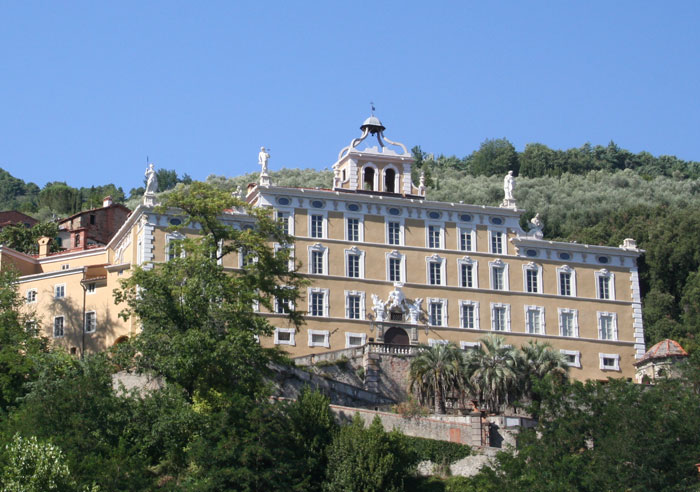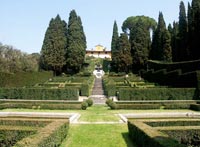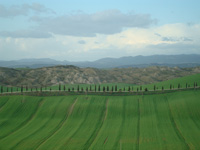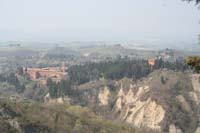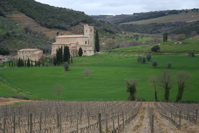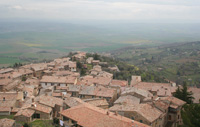| |
|
Before becoming famous for having created the pseudonym of Carlo Lorenzini – the ‘father’ of Pinocchio – the village of Collodi was famous for the Villa Garzoni and its garden whose fame spread beyond the borders of the Duchy of Lucca even in the 17th century. The villa and garden constituted a unified complex built between the 17th and 18th centuries in an architectural style that, fortunately, still today remains with very few alterations.[2] The Garden opens like a splendid theatre with water games and special facilities. It can be compared to some of the finest gardens in Italy and Europe, as it expresses many post-Renaissance ideas and styles. Its rigorous geometric structures are tempered by gentle greenery, comical elements and fantastic statues and fountains. In the sixteenth century, the Garzoni garden consisted of a small area near the palace which was set up on three varying levels of terrain.
The historic Garzoni Garden, one of the most beautiful in Italy, represents a felicitous synthesis between Renaissance geometry and the spectacular quality of the nascent Baroque. The garden is a work of art of rare equilibrium, where the greenery, the flights of steps the water plays and statues form a truly unique ensemble. It is an absolutely unforgettable experience to lose oneself amidst the wonders of this fantastic place: grottoes, theatres carved out of box hedges, statues representing mythological creatures, satyrs, female figures, greenhouses with peacocks, forests of bamboo. An ancient, and somewhat arch tradition considers the visit to be propitious for lovers, and not only on account of the leafy shade and the arbours that offer secluded spots for tender caresses, but also of the maze, a symbolic allusion to the path to follow together throughout life. As soon as we enter the garden we come upon delightful parterres, statues and two large circular pools. Proceeding we then reach two magnificent double ramps of steps featuring a complex hydraulic system that supplies the water plays. These steps lead to the three upper terraces. Beyond is the impressive water staircase, flanked by two female statues representing the eternal rivals Lucca and Florence. At the very top is the statue of Fame blowing into a shell, emerging from which a jet of water traces out a lofty arc. Leading off the main route through the garden are numerous side paths and avenues where we can discover its marvels among the fragrances of the different plants, the plays of light and shade of the vegetation, the intrigue of the mazes and the enchantment of the sculptures.
The Villa, still in phases of reconstruction, seems to restrain the antique village, that climbs up behind, on the hill. A walk from the Castle alley will take the visitor back in time to a really particular atmosphere.
|
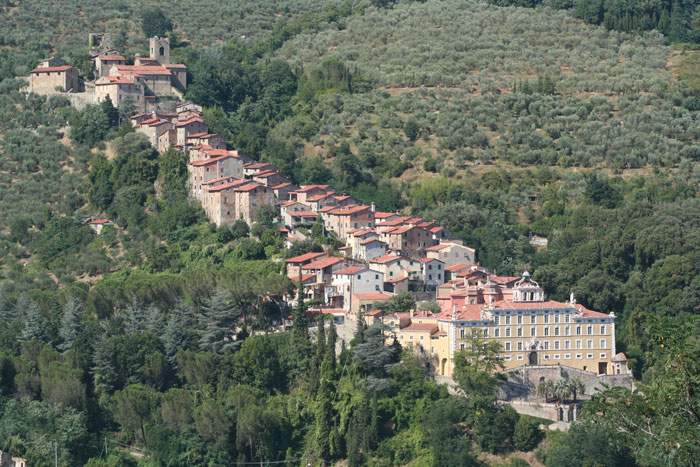 |
The Villa Garzoni and its ornamental garden stands at the foot of the ancient medieval village of Collodi,
|
History of Garzoni Garden
Designed in the eighteenth century by the Lucca architect, Ottaviano Diodati, the garden opens up like a breathtaking stage set, with water plays and large starry pools. The majestic Villa Garzoni, also known as the Villa of a Hundred Windows, could not be graced with anything less than the magnificent garden which is still splendidly intact. The garden was laid out when the villa was built in the seventeenth century by the Garzoni family, originating from Pescia and of Ghibelline leanings, which after the death of Castruccio Castracani had suffered the confiscation of their goods, banishment and exile. Having taken refuge in Lucca, where the members of the family had risen to the highest ranks of office, when they decided to build a villa the ancient taste for provocation and challenge led them to select this site on the ancient border between the Grand Duchy and the Republic of Lucca. The first certain record of the villa dates to 1633 and to the Marquis Romano di Alessandro Garzoni. The latter was probably also the first architect of the garden, the main lines of which were already traced out in 1652, later enhanced by statues and magnificent water plays in the following century. The atmosphere of carefree delight of the villa reached its peak in the pavilion of the Baths, where the ladies and gentlemen could take their ease and engage in exchanging coy glances amidst jets of water, mirrors and verdant mazes.
|
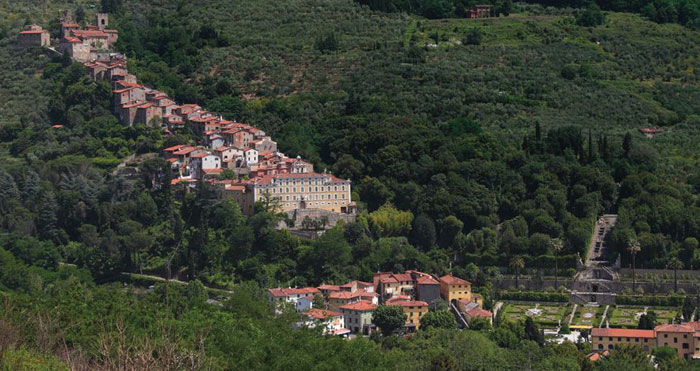 |
The Villa Garzoni and its ornamental garden stands at the foot of the ancient medieval village of Collodi,
almost as though it supported its weight.
The garden’s planimetric layout was influenced by the marked sloping of the terrain, and is characterised by terracing along an axis of symmetry.
The town, villa and garden are three elements which, though clearly distinct, harmoniously complement each other. The Monumental Park of Pinocchio, located in the vicinity of the Villa, is a strong tourist attraction and, at the same time, an example of great architectural importance.
|
|
|
|
| |
|
'The complex as it appears today is the result of a renovation project begun in the mid-17th century by the architect Ottaviano Diodati in collaboration with Romano Garzoni, the then owner of the property. The villa, an imposing structure with four floors on the valley side and three on the side facing the hill, stands on higher ground than its surroundings. Two broad-stepped ramps, which heighten the theatrical effect, connect the villa to the garden at the side. In a leafy space behind the main building, stands a building of particular interest, designed by Filippo Juvarra. This bright-red building is generally considered as one of the most important expressions of Baroque architecture in Tuscany. The steep slope of the site heavily influenced the way in which the garden was laid out: symmetrically arranged around a central axis, it takes the form of a series of terraces that create a beautiful perspective effect. The layout cleverly blends the geometrical principles of the Renaissance with the spectacular effects typical of the burgeoning Baroque movement. The entrance, with its statues of Pan the Piper and Flora, leads first to an elaborate parterre with geometrically planted box hedges, whose flowerbeds were recently replaced with fine coloured gravel. The first section has two circular basins with attractive lily pools and water jets. Statues of Diana and Apollo lead on to the second part of the parterre where the insignia of the Garzoni family are represented in the flower-beds. At the end of the parterre, which is bordered by an imposing box hedge with topiary effects, stands a majestic double flight of steps, decorated with coloured mosaics and geometrical designs and niches containing terracotta statues. An impressive balustrade runs the entire length of the flight of steps. At one end of the first stairhead a path leads to a statue of Pomona, the ancient goddess of the cultivated garden, a path at the other leads off to a teatrino di verzura, an open-air theatre created in the greenery and a typical feature of Tuscan gardens. The central axis continues along a stepped waterfall that culminates in a statue of Fama, from whose cornucopia water pours forth. The water flows into a semi-circular pool then down into the central cascade. This display is set in a dense wood, cut across by various paths: one of these continues to a bamboo thicket; another crosses a pergola-covered bridge with porthole openings and leads to a maze. The garden was recently restored on the basis of documented descriptions and models worked out from the study of treatises.'[1]
|
|
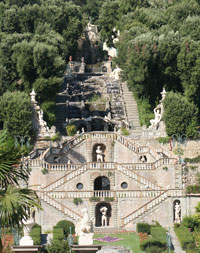
The Garzoni Villa in Collodi, garden |
The solemnity of the façade contrasts with the "Summer Palazzina" built by Juvarra creating a surprising scenic effect typical of baroque taste. As soon as you pass through the main door, the Palazzina presents itself with its light and curved lines, the bright chromatic effects achieved by the red plaster, the mosaics and the pebbled wall work.
|
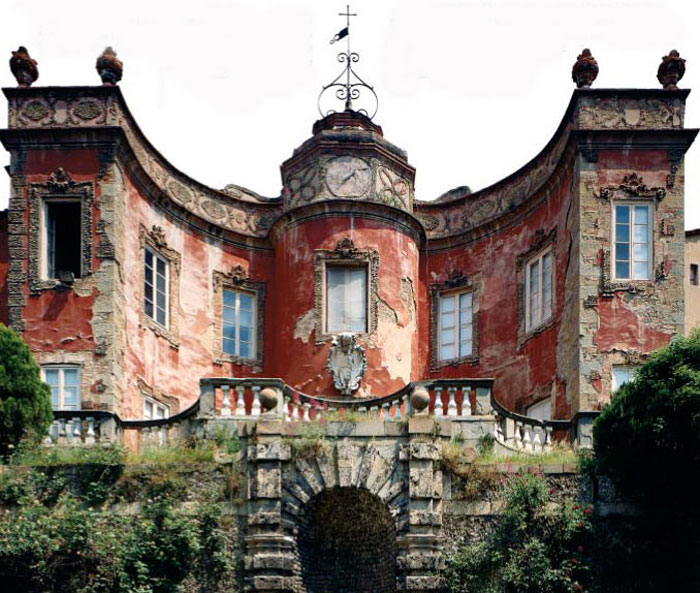 |
The Garzoni Villa in Collodi, Palazzina d'estate
|
The Garzoni family was originally from Pescia. As they politically sided with the Ghibelline party, they had been forced into exile due to power struggles. They found refuge in Lucca, in a locality bordering the Grand Ducal territories and the Republic of Lucca. Historical sources first refer to the castle in 1633, mentioning the Roman Marchese, Alessandro Garzoni, who was probably the Garden’s first architect. The villa’s garden is thought to have had its current characteristics as far back as 1652. In order to create this extraordinary complex, it took no less than 170 years. The ‘Palazzina d’estate’, one of the structure’s last wonders, was built by Ottabiano Diodati, a Tuscan illuminist scholar.
Le Pompe di Collodi written in 1552 is the first literary work that celebrates the garden’s grandiosity, describing its labyrinth, bridge and forest—all of which can still be enjoyed today. A map from 1680 showcases the garden’s structure. The villa—called ‘the villa of a hundred windows’—is seeped in history. It once hosted Napoleon and Carlo Lorenzini’s father worked in the villa’s immense kitchen. It is located in the ancient hamlet of Collodi, one of the most beautiful hillside towns in Tuscany.
|
Villa Garzoni in Collodi
Address: piazza della Vittoria 1, Collodi, Pescia,locality Collodi.
The garden of the villa can be visited during the following hours:
Summer (15th March/30th October): from 9a.m. - sunset
Winter (1st November/14th March): from 9a.m.- hour before sunset
The Butterfly House and Pinocchio Park
Pinocchio Park cannot be anywhere else but Collodi, where the antique village has been for more than a century, with its characteristic waterfall of houses that go from the top of the hill stopping behind Villa Garzoni with its 17th Century scenic Garden. Pinocchio Park was opened in 1956, not as a customary theme park but as a journey through the fairytale.

[1] From Giardini in Toscana - Gardens in Tuscany Un viaggio attraverso la storia dei giardini • A journey through the history of gardens | www.regione.toscana.it
[2] Carlo Lorenzini (1826 – 1890), better known by the pen name Carlo Collodi, was an Italian children's writer known for the world-renowned fairy tale novel, The Adventures of Pinocchio.
may be seen in his earliest literary works as well as in the founding of the satirical newspaper Il Lampione. This newspaper was censored by order of the Grand Duke of Tuscany in 1849 but re-emerged in May 1860.
Lorenzini had won fame as early as 1856 with his novel In vapore and had also begun intense activity on other political newspapers such as Il Fanfulla; at the same time he was employed by the Censorship Commission for the Theatre. During this period he composed various satirical sketches and stories (sometimes simply by collating earlier articles), including Macchiette (1880), Occhi e nasi (1881), Storie allegre (1887).[citation needed]
In 1875, he entered the domain of children's literature with Racconti delle fate, a translation of French fairy tales by Perrault. In 1876 Lorenzini wrote Giannettino (inspired by Alessandro Luigi Parravicini's Giannetto), the Minuzzolo, and Il viaggio per l'Italia di Giannettino, a series which explored the re-unification of Italy through the ironic thoughts and actions of the character Giannettino.
Lorenzini became fascinated by the idea of using an amiable, rascally character as a means of expressing his own convictions through allegory. In 1880 he began writing Storia di un burattino ("The story of a marionette"), also called Le avventure di Pinocchio, which was published weekly in Il Giornale dei Bambini (the first Italian newspaper for children).
Death and legacy
Lorenzini died in Florence in 1890, unaware of the fame and popularity that awaited his work: as in the allegory of the story, Pinocchio eventually went on to lead his own independent life, distinct from that of the author
Lorenzini is buried at San Miniato al Monte Basilica in Firenze.
Bibliography
Isa Belli Barsali, La Villa a Lucca dal XV al XIX secolo, De Luca, Roma, 1964
I. Belli Barsali, Ville e committenti nello stato di Lucca, Maria Pacini Fazzi, Lucca, 1980
|
|
|
This article incorporates material from the Wikipedia articlesVilla Garzoni and Carlo Collodi, published under the GNU Free Documentation License, and some information from The Garzoni garden and villa (www.turismo.intoscana.it).
|
|
|
| |
| |
|
| |
|
|
|
|
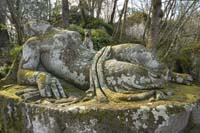
|
Podere Santa Pia |
|
Podere Santa Pia, view from the garden
on the valley below
|
|
Il parco dei Mostri di Bomarzo |
| |
|
|
|
|
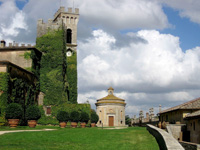
|
|
|
|
|
Villa Celsa
|
|
Villa I Tatti, near Settignano, outside Florence |
|
Val d'Orcia |
| |
|
|
|
|
|
|
|
|
|
Monte Oliveto Maggiore abbey |
|
Abbey of Sant 'Antimo |
|
Montalcino |
| |
|
|
|
|
Lucca is renowned all over the world for its city walls, erected between 1504 and 1645. An important example of military architecture, the walls, which have never been used for defensive purposes, have been transformed into a charming promenade around the city.
Lucca is called the hundred-church town because of its numerous buildings of worship, the most important being the Cathedral of San Martino, the church of San Giovanni and Santa Reparata, San Michele in Foro and San Frediano.
Very famous is also Via Fillungo, with its Medieval buildings. The street leads to Piazza dell`Anfiteatro, which today is called Piazza del Mercato, where once stood the Roman amphitheatre.
The Torre Guinigi (Guinigi Tower), once the house of Paolo Guinigi, who governed Lucca from 1400 to 1430, and the Teatro del Giglio are worth a visit, too.
Pisa, one of the four ancient maritime republics, was once one of the most important Tuscan cities and a sworn enemy of Florence, Livorno and Lucca. Today, Pisa is one of the world`s most renowned and visited cities of art, thanks to the Leaning Tower, to the whole Piazza dei Miracoli - one of UNESCO`s World Heritage sites - and many other little jewels of Italian art, such as the churches of Santa Caterina, Santa Maria della Spina and San Paolo a Ripa d`Arno.
The Etruscan findings in Volterra and Pisa`s folkloric events, such the "Palio delle Repubbliche Marinare" (Regatta of the maritime republics) and the "Gioco del ponte" (Battle of the bridge), testify the city and province`s past.
Pistoia was once an important Lombard town and a lively and flourishing autonomous centre before definitively surrendering to Florence in 1530 (the year in which the town became part of the Grand Duchy of Tuscany). Although it is not a mass tourism destination, Pistoia is rich in interesting monuments, such as the Cathedral, the Baptistery, the Palazzo del Comune and the church of the Madonna dell`Umiltà.
Much more famous are the tourist centres scattered in the province: the Abetone ski resort, where Tuscan skiers spend their winter weekends, and the thermal resorts of Montecatini Terme and Monsummano Terme.
Prato was born in the 11th century from the union of the two villages of Borgo al Cornio and Castrum Prati. In the course of time, Prato was dominated by Pistoia and Florence, before being elevated to city status in 1653. Today, as in the past, Prato is an important industrial district in northern Tuscany, renowned all over the world thanks to its textile industry.
Although Prato cannot boast as rich an artistic heritage as neighbouring Florence, it nevertheless has interesting monuments, such as the Cathedral, the church of Santa Maria delle Carceri and the gothic church of San Domenico.
The Medicean villa in Poggio a Caiano is just a few kilometres away from Prato. The villa was one of the numerous residences the Medici family had in the countryside around Florence.

Villa Bellavista | In 1673, Francesco Feroni purchased a landholding from Grand Duke Cosimo III de’ Medici, situated on a hill that perhaps originated from the reclamation of a swamp area of Fucecchio, along with 45 farms in the Valdinievole. In the five years that followed, Feroni carried out a number of works, including the construction of a mill and a kiln. In 1696, Fabio Feroni, son of Francesco, started building the villa we still admire today, entrusting the project to Antonio Maria Ferri from Florence, the Grand Duke’s trusted architect and author of a Trattato di pratiche di prospettiva, fortificazioni e d'artiglieria [Treatise of Practises in Perspective, Fortifications and Artillery].
The grandiose building has four projecting corner towers and a facade in the Baroque style with a balcony that runs along the perimeter of the villa at the height of the piano nobile. Successively, a large clock was placed at the top of the facade. The entrance is formed by a portico with three arches. Inside, the rooms are distributed around an enormous main hall with frescoes, and disposed so as to create spectacular effects of perspective.
A majestic lane with a series of statues on either side and various ornamental vases traverses the garden, which was embellished by a large pool at the entrance. Water was brought to the villa by means of a plumbing system that drew it from the hill of Stignano. In 1699, Ferri designed an elegant and noble chapel in the garden.
Through the years, the villa witnessed a succession of moments of prosperity alternated with periods of decline, and in the 20th century, even of degradation. In 1938, it became property of the Ministry of the Interior which destined it to the Firemen’s National Assistance Society. It has been the headquarters of a solar therapy colony, and during World War II it was a hospital. An exhibition itinerary is presently being set up in several rooms in the Villa and will soon become the Firemen’s Regional Historical Museum.
Address: Buggiano, loc. Santa Maria, Via Livornese 28
Villa Puccini | Known with the name of villone, the villa was built for Tommaso Puccini in the first half of the 18th century with the earnings from his profession as physician, and was modified in the course of time until it assumed its present neoclassical look.
In the 19th century, Niccolò Puccini, a promoter of the Parentalia Society to Great Italians, placed at the disposal of Filippo Pacini a microscope that the Pistoian scientist used in the villa to conduct his first anatomical and histological studies.
The spacious garden, realised between 1821 and 1844 by order of Niccolò Puccini, was furnished with various buildings, several of which were dedicated to science: a Pantheon to illustrious men, a Temple of Pythagoras, a monument to science, one to industry, a hemicycle dedicated to Galileo Galilei and a column surmounted by a statue of Carl Linnaeus, to whose memory the park was dedicated. The disposition of the hydraulic structure of the two lakes and of the brooks was entrusted to Pistoian architect Giovanni Gambini who, in that period, was also working on Villa Celle.
Emanuele Repetti defined the garden as a place «enchanted that would be difficult to describe as it deserves». Today, it no longer presents its original aspect, and several of its monuments have disappeared. Substantially unchanged, however, is the Gothic Castle (or Fortress), one of the monumental buildings that enriched the garden and that in 1836 became the habitual residence of Niccolò Puccini. Precise nineteenth-century descriptions, drafted on the occasion of the sale by auction of the property, testify that the middle tower had a lighting conductor on top of the roof, and curious contraptions which, according to a widespread anecdote, permitted Niccolò Puccini not to abandon his bedroom to receive guests: «the inner wall of this bedroom houses various brass handles that, by means of a proper mechanism, serve to open and close the window, open and close the entry gate and other uses, today out of order».
The property was divided first due to the construction of the road for Porretta, the new Via Leopolda (1847), and then by the construction of the Porrettana Railway (1864). The area that embraces the Fortress, the Gothic temple, the pantheon and several monuments, including the one to Galileo, were purchased in 1867 by Florentine attorney Oreste Ciampi. The remaining part of the complex is today a public park.
Address: Pistoia, Via Dalmazia 356
Villa Celle | Villa Celle began to take on its present appearance as of the second half of the 17th century, when the Fabroni family began to modernise it. Cardinal Carlo Agostino Fabroni, in particular, organised the orchard plantations, the farms, and reordered the waterworks, building pools, nymphaeums and fountains. The facade is characterised by its large Baroque pediment and clock, which recalls the analogous solution of the Villa di Bellavista. In the second half of the 18th century, work began on the villa’s new service road, which tradition claims was done on a project by Leonardo Ximenes. The gardens and woods were laid out on typically Baroque geometric schemes. A "Chinese" aviary of brick and iron was built in 1812. Between 1841 and 1842, a rectangular waterbody was excavated on the northern edge of the woods to produce the ice for the icehouse, which was formed by a well having the shape of a truncated cone, made of dry-walled stone blocks, and equipped with a drainage canal and a catch basin for the infiltration waters. The icehouse water was also utilised in the dairy, a small building that recalls the icehouses of the Pistoian mountain.
The transformation into a romantic park was carried out in the mid 19th century under the direction of Pistoian architect Giovanni Gambini. The little "Chinese" lake with natural forms was inaugurated in 1845. Its little island resting on grottoes had a berth for small boats and a little neoclassical temple. A small bridge that passed over a rocky ravine with a waterfall led to the lake. The year 1848 marked the onset of work on an amphitheatre with natural forms, crowned by the neo-gothic "Temple of the Fountain-head" (today the "Tea House"). The results that Gambini achieved were so remarkable that Niccolò Puccini summoned him for the lake of his own villa at Scornio.
In the late 19th century, the lemon-house was renovated to its present form, and the Michelucci Foundry was commissioned with manufacturing the gates for the villa and farm. During World War II, the villa was occupied by a German military command post and transformed into a hospital, while a bunker was excavated in the park. In 1969, the Celle property was purchased by entrepreneur Giuliano Gori who collected contemporary art, and here formed the first collection of environmental art.
Address: Pistoia, Santomato, Via Montalese 7/A
Garden of the Villa Reale di Marlia | The Villa Marlia is an Italian Renaissance residence in the province of Lucca. It is famous for its water garden, especially the water theatre.
The earliest records of Villa Reale di Marlia date back to 1517, when the Buonvisi family purchased the property from the Avvocati family. In 1651 it passed into the hands of Oliviero and Lelio Orsetti, and it was these new owners who, as a late 18th century print demonstrates, redesigned the garden and built the so-called Palazzina dell'Orologio, or "clockhouse". This building has a loggia over the doorway, with a raised section above containing the clock that gives the building its name. The building was called "'Marly", in memory of a villa of the same name that existed near Paris at the time of Louis XIV.
Gardens in Tuscany | Villa Reale di Marlia and other gardens around Lucca
|
The historic Garzoni Garden is a member of the Grandi Giardini Italiani, an association of major gardens in Italy. Its members include some of the most important gardens in Italy.
List of member gardens | Fondazione Pompeo Mariani (Imperia), Giardini Botanici di Stigliano (Roma), Giardini Botanici di Villa Taranto (Verbania), Giardini Botanici Hanbury (Ventimiglia), Giardini della Landriana (Roma), Giardini La Mortella (Napoli), Giardino Barbarigo Pizzoni Ardemani (Padova), Giardino Bardini (Firenze), Giardino dell'Hotel Cipriani (Venezia), Giardino di Boboli (Firenze), Giardino di Ninfa (Latina), Giardino di Palazzo del Principe, Giardino di Villa Gamberaia (Firenze), Giardino Ducale di Parma, Giardino Esotico Pallanca (Imperia), Giardino Giusti (Verona), Giardino Storico Garzoni (Pistoia), Gardens of Trauttmansdorff Castle (Merano), Giardino del Biviere (Siracusa), Serraglio di Villa Fracazan Piovene (Vicenza), Vittoriale degli Italiani (Brescia), Cervara, Abbazia di San Girolamo al Monte di Portofino (Genova), Venaria Reale, Museo Giardino della Rosa Antica (Modena), Museo Nazionale di Villa Nazionale Pisani (Venezia), Oasi di Porto (Roma), Orto Botanico dell'Università di Catania, Palazzo Fantini (Forlì), Palazzo Parisio (Malta), Palazzo Patrizi (Roma), Parco Botanico di San Liberato (Roma), Parco del Castello di Miramare (Trieste), Parco della Villa Pallavicino (Verbania), Parco della Villa Reale di Marlia (Lucca), Parco di Palazzo Coronini Cronberg (Gorizia), Parco di Palazzo Malingri di Bagnolo (Cuneo), Parco di Pinocchio (Pistoia), Parco Giardino Sigurtà (Verona), Parco Idrotermale del Negombo (Napoli), Parco Paternò del Toscano (Catania), Parco Storico Seghetti Panichi (Ascoli Piceno), Varramista Gardens (Pisa), Villa Arvedi (Verona), Villa Borromeo Visconti Litta (Milano), Villa Carlotta (Como), Villa del Balbianello (Como), Villa della Porta Bozzolo (Varese), Villa d'Este (Como), Villa d'Este (Tivoli), Villa di Geggiano (Siena), Villa Durazzo (S. Margherita Ligure, GE), Villa Farnese di Caprarola (Viterbo), Villa Grabau (Lucca), Villa La Babina (Imola), Villa La Pescigola (Massa), Villa Lante (Viterbo), Villa Melzi d'Eril (Como), Villa Montericco Pasolini (Imola), Villa Novare Bertani (Verona), Villa Oliva-Buonvisi (Lucca), Villa Peyron al Bosco di Fontelucente (Firenze), Villa Pisani Bolognesi Scalabrin (Padova), Villa Poggio Torselli (Firenze), Villa San Michele (Napoli), Villa Serra (Genova), Villa Trento Da Schio (Vicenza), Villa Trissino Marzotto (Vicenza), Villa Vignamaggio (Firenze).
Grandi Giardini Italiani (Italian) | www.grandigiardini.it
|
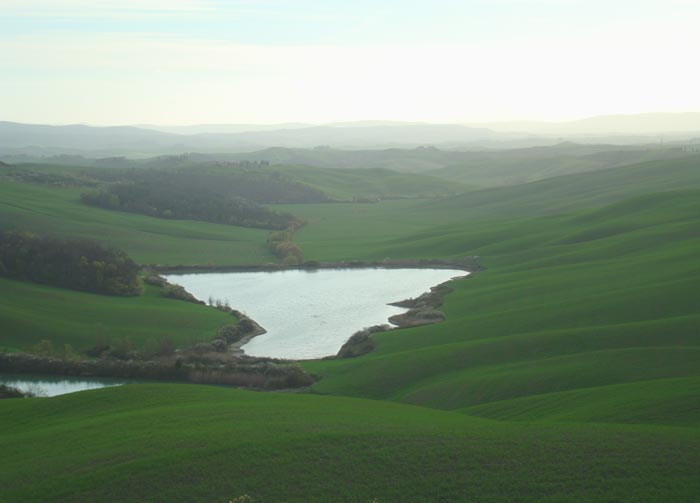 |
Crete Senesi, surroundings of Podere Santa Pia |
|
|
